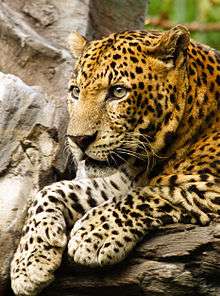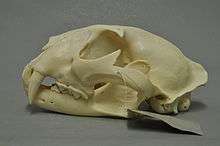Javan leopard
The Javan leopard (Panthera pardus melas) is a leopard subspecies confined to the Indonesian island of Java. It has been listed as Critically Endangered on the IUCN Red List since 2008. The population is estimated at less than 250 mature individuals, with a decreasing population trend. The total remaining habitat is estimated at only 2,267.9 to 3,277.3 km2 (875.6 to 1,265.4 sq mi).[1]
| Javan leopard | |
|---|---|
 | |
| Javan leopard in a safari park in Bali, Indonesia | |
| Scientific classification | |
| Kingdom: | Animalia |
| Phylum: | Chordata |
| Class: | Mammalia |
| Order: | Carnivora |
| Suborder: | Feliformia |
| Family: | Felidae |
| Subfamily: | Pantherinae |
| Genus: | Panthera |
| Species: | |
| Subspecies: | P. p. melas |
| Trinomial name | |
| Panthera pardus melas (G. Cuvier, 1809) | |
Characteristics
The Javan leopard was initially described as being black with dark black spots and silver-grey eyes.[2] Javan leopards have either a normal spotted coat, or a recessive phenotype resulting in an all-black coat.[3]
Distribution and habitat
The Javan leopard is confined to the Indonesian island of Java. It is known to inhabit Gunung Halimun National Park, Ujung Kulon National Park, Gunung Gede Pangrango National Park, Ceremai National Park, Merbabu National Park, Merapi National Park, Bromo Tengger Semeru National Park, Meru Betiri National Park, Ijen Mountain, Baluran National Park, and Alas Purwo National Park.[1] It inhabits altitudes from sea level to 2,540 m (8,330 ft) ranging from dense tropical rainforest to dry deciduous forests. Outside protected areas, it was recorded in secondary forest, mixed agriculture and production forest between 2008 and 2014.[4]
In the 1990s, it survived in the seral stages of successional vegetation patterns, which made it less susceptible to humans' disruptive activities than many other mammals.[3]
From 2001 to 2004, monitoring research has been conducted in a 20 km2 (7.7 sq mi) area of Gunung Halimun National Park using camera traps and radio tracking. Seven leopards were identified in the study area. The total population was estimated at 42 to 58 individuals. The home range of an adult female averaged 9.82 km2 (3.79 sq mi).[5]
Ecology and behavior

The Javan leopard's prey comprises barking deer, wild boar, Java mouse-deer, and primates such as crab-eating macaque, silvery lutung, and Javan gibbon. Javan leopards also look for food in close by villages and have been known to prey on domestic dogs, chickens, and goats.[3] Two leopards were radio collared in the Gunung Halimun National Park. Their daily activity pattern showed peaks in the early mornings between 6:00 and 9:00, and late afternoons between 15:00 and 18:00.[5]
Threats


The Javan leopard is threatened by loss of habitat, prey base depletion, and poaching due to human population growth and agricultural expansion.[1] Conflict between local people and leopards is also considered to be a main threat to the Javan leopard.[5] Java has lost more than 90% of its natural vegetation and is one of the most densely populated islands in the world. Primary forests remain only in the mountainous regions at elevations above 1,400 m (4,600 ft).[3]
Conservation
Panthera pardus melas is listed in the CITES Appendix I.[1]
Efforts are being made to restore the Javan leopard population and prevent its extinction. Hunting laws are strictly enforced. In 2005, Gunung Halimun National Park was enlarged to three times its original size for the protection of the Javan leopard, the silvery gibbon (Hylobates moloch), and the Javan hawk-eagle (Nisaetus bartelsi).[5]
To address the issue of Java's overpopulation and encroachment on habitat of protected species, the Indonesian government has formed a nationwide family planning program. This program makes contraceptive devices like condoms and several different forms of birth control pills more readily available to the public.[6]
In captivity
In 1997, 14 Javan leopards were kept in European zoos. The Javan leopard is not specifically managed in captive breeding programs in Europe and America. As of 2007, the Taman Safari Zoo in Bogor, Indonesia, kept 17 Javan leopards — seven males and 10 females, of which four were breeding pairs. The Indonesian zoos of Ragunan and Surabaya also keep Javan leopards.[7] As of December 2011, two male and one female Javan leopard were kept in Tierpark Berlin, Germany; and one male and one female in the Jakarta Zoo.[8] In 2013, one male Javan leopard was transferred from Tierpark Berlin to the Prague Zoo.[9]
Evolution
Morphological research indicates that the Javan leopard is craniometrically distinct from other Asian leopard subspecies, and is a distinct taxon that split off from other Asian leopard subspecies in the Middle Pleistocene about 800,000 years ago. In the Middle Pleistocene, it may have migrated to Java from South Asia across a land bridge that bypassed Sumatra and Borneo.[10]
See also
Leopard subspecies: African leopard · Arabian leopard · Anatolian leopard · Persian leopard · Indian leopard · Indochinese leopard · Sri Lankan leopard · Amur leopard · Panthera pardus spelaea
References
- Stein, A.B.; Athreya, V.; Gerngross, P.; Balme, G.; Henschel, P.; Karanth, U.; Miquelle, D.; Rostro, S.; Kamler, J.F. & Laguardia, A. (2016). "Panthera pardus". IUCN Red List of Threatened Species. 2016: e.T15954A160698029.
- Cuvier, G. (1809). "Recherches sur les espėces vivantes de grands chats, pour servir de preuves et d'éclaircissement au chapitre sur les carnassiers fossils". Annales du Muséum National d'Histoire Naturelle. Tome XIV: 136–164.
- Santiapillai, C.; Ramono, W. S. (1992). "Status of the leopard (Panthera pardus) in Java, Indonesia" (PDF). Tiger Paper. XIX (2): 1–5. Archived from the original (PDF) on 2011-09-02. Retrieved 2011-04-21.
- Wibisono, H.T., Wahyudi, H.A., Wilianto, E., Pinondang, I.M.R., Primajati, M., Liswanto, D. and Linkie, M. (2018). "Identifying priority conservation landscapes and actions for the Critically Endangered Javan leopard in Indonesia: Conserving the last large carnivore in Java Island". PLOS ONE. 13 (6): e0198369. Bibcode:2018PLoSO..1398369W. doi:10.1371/journal.pone.0198369. PMC 6021038. PMID 29949588.CS1 maint: multiple names: authors list (link)
- Harahap, S., Sakaguchi, H. (2005). Ecological research and conservation of the Javan Leopard Panthera pardus melas in Gunung Halimun National Park, West Java, Indonesia. In: The wild cats: ecological diversity and conservation strategy. The 21st Century Center of Excellence Program International Symposium. Okinawa, Japan.
- Embassy of the Republic of Indonesia in London (2009). "A Solution to Java's Overcrowding". United Kingdom. Archived from the original on March 13, 2010. Retrieved December 8, 2009.
- Gippoliti, S.; Meijaard, E. (2007). "Taxonomic uniqueness of the Javan Leopard: an opportunity for zoos to save it". Contributions to Zoology. 76: 55–58. doi:10.1163/18759866-07601005.
- International Species Information System (2011). "ISIS Species Holdings: Panthera pardus melas, December 2011".
- Exner, O. (2013). "Rare Leopard in Prague Zoo". Portal of Prague. Archived from the original on 2013-10-13.
- Meijaard, E. (2004). "Biogeographic history of the Javan leopard Panthera pardus based on craniometric analysis". Journal of Mammalogy. 85 (2): 302–310. doi:10.1644/ber-010.
External links
| Wikimedia Commons has media related to Panthera pardus melas. |
- Species portrait Panthera pardus in Asia and short portrait P. pardus melas; IUCN/SSC Cat Specialist Group
- Critically Endangered Javan Leopard Captured on Camera Traps in Ujung Kulon, Indonesia
